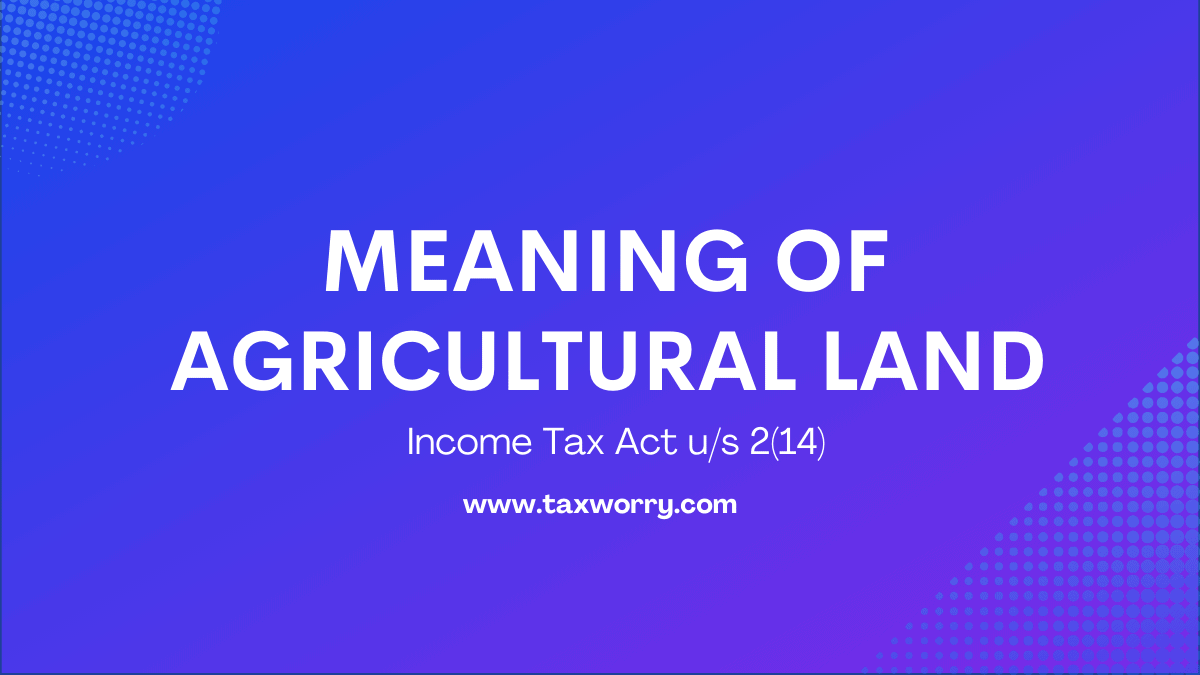Meaning of tax terms
Meaning of “Agricultural land”
The meaning of agricultural land under section 2(14) of the Income Tax Act is not defined in the act itself. But we can take guidance from decisions by various high courts. Here are excerpts of courts orders in which the Hon’ble High Court tried to explain the meaning of agricultural land.

Meaning of agricultural land defined by court
The phrase ‘agricultural land’ used in section 2(14) of the Income Tax Act came up before various high courts as detailed under :
1. Hon’ble supreme court explained the meaning of ‘agricultural land’ while delivering judgment in CWT v. Officer-in-charge (court of wards) [1976] 105 ITR 133 (SC) as under :
Meaning : Agricultural land’ is only a species of land. Simply because it has not been defined in the wealth-tax act, it is not correct to give the expression as wide a meaning as possible, since widest possible connotation, if given, will include all land, even that covered by buildings, as ‘agricultural land’. The object of wealth-tax act is to tax surplus wealth. It is clear that all land is not excluded from the definition of ‘assets’.
It is only ‘agricultural land’ which can be exempted. Therefore, it is imperative to give reasonable limits to the scope of the ‘agricultural land’. Accordingly, if there is neither anything in its condition nor anything in evidence to indicate the intention of its owners or possessors, so as to connect it with an agricultural purpose, the land could not be ‘agricultural land’ for the purpose of earning an exemption under the act.
Note : the cases given below though are in context of wealth-tax act, they are relevant for purposes of section 2(14) also.
2. Hon’ble bombay high court explained the meaning of ‘agricultural land’ while delivering judgment in CWT vs. H.V. Mungale [1984] 145 ITR 208 (Bom.) as under :
Meaning : In a given case agricultural land may or may not yield agricultural income. If there is land which was once cultivated or put to agricultural use but is now fallow or barren, it would not merely by reason of such fact cease to be agricultural land.
Conversely what is patently non-agricultural land may in extraordinary circumstances be used for a purpose to which agricultural land is usually put and may, therefore, yield agricultural income. However, merely by reason of the yield it cannot be designated as agricultural land.
Where the land is being assessed as agricultural land, then, normally, although it is not being put to actual agricultural use, it may be presumed that it continues to be agricultural land, unless it can be shown that it has been in fact put to some non-agricultural use, or there are some relevant circumstances to indicate that it cannot be properly regarded as agricultural land.
Land which is recorded as agricultural land in the revenue papers cannot be used for a non-agricultural purpose by the owner, unless the land is allowed to be converted to non-agricultural purposes by the collector under the provisions of the relevant land revenue act or the land revenue code. This is a circumstance which must necessarily be taken into account while determining the character or the nature of the land.
3. Hon’ble Delhi high court explained the meaning of ‘agricultural land’ while delivering judgment in Shiv shankar lal v. CIT [1974] 94 ITR 433 (Delhi) as under :
Meaning : In order to come within the category of ‘agricultural land’, the land must not only be capable of being used for agricultural purposes but should have been actually used as such at some point of time. A temporary non-user for agricultural purposes will not affect the character of the land but a permanent abandonment of user for agricultural purposes will affect the character of the land as agricultural land. The actual conversion of the land for non-agricultural purposes will also affect the character of the land as agricultural land. Whether such a conversion has taken place will depend on the facts of each case.
4. Hon’ble Kerala high court explained the meaning of ‘agricultural land’ while delivering judgment in Venugopala varma rajah v. Ced [1967] 64 ITR 358 (Ker.) as under :
Meaning : Agricultural land is land on which a prudent owner will undertake any of the processes of farming in its widest sense.
5. Hon’ble Andhra Pradesh High Court explained the meaning of ‘agricultural land’ while delivering judgment in Smt. Manyam meenakshamma v. CWT [1967] 63 ITR 534 (AP) as under :
Meaning : If a land is ordinarily used for purposes of agriculture or for purposes sub-servient to or allied to agriculture, it would be an agricultural land; if it is not so used, it would not be agricultural land.
6. Hon’ble Kolkata High Court explained the meaning of ‘agricultural land’ while delivering judgment in Tea estates india (p.) Ltd. V. CWT [1966] 59 ITR 428 (Cal.) as under :
Meaning : Agricultural land’ should comprise the following characteristics : a. It must be a land; b. It must pertain to or be connected with cultivation; c. It must involve expenditure of human labour and skill for the purpose of cultivation or for keeping it in a cultivable state.
7. Hon’ble Gujarat High Court explained the meaning of ‘agricultural land’ while delivering judgment in Rasiklal Chimanlal Nagri vs. CWT [1965] 56 ITR 608 (Guj.) as under :
Meaning : Whether land is agricultural land or not cannot depend on the fluctuating or ambulatory intention of the owner of the land. The criterion must be something more definite, something more objective, something related to the nature or character of the land and not varying with the intention of the owner as to the use to which he wants to put the land at a particular point of time.
Of course, this must not be understood to mean that the intention as to user is altogether an irrelevant consideration; it is certainly a factor which would bear on the nature or character of the land but it does not afford a sole or exclusive criterion for determining whether a land is agricultural land or not. Where the land is actually put to use, there is usually not much difficulty in ascertaining the nature or character of the land.
If the land is used for agricultural purposes, ordinarily it would be correct to say that the land is agricultural land and vice versa. But even this test may not always furnish a correct answer, for, there may be cases where land admittedly non-agricultural (such as a building site) may be used temporarily for agricultural purposes. In such cases it would not be correct to say that merely because the land is in fact being used for agricultural purposes, it is agricultural land.
But as a general proposition it may be stated without any fear of contradiction that ordinarily the actual user to which the land is being put would furnish prima facie evidence of the true nature or character of the land and, therefore, whenever a question arises whether a particular land is agricultural land or not, primarily regard must be had to the purpose for which the land is being actually used at or about the relevant time and that would ordinarily provide a satisfactory answer to the problem.
Section 2(14) of Income Tax Act
2(14) “capital asset” means—
(a) property of any kind held by an assessee, whether or not connected with his business or profession;
(b) any securities held by a Foreign Institutional Investor which has invested in such securities in accordance with the regulations made under the Securities and Exchange Board of India Act, 1992 (15 of 1992);
5[(c) any unit linked insurance policy to which exemption under clause (10D) of section 10 does not apply on account of the applicability of the fourth and fifth provisos thereof,]
but does not include—
(i) any stock-in-trade [other than the securities referred to in sub-clause (b)], consumable stores or raw materials held for the purposes of his business or profession ;
(ii) personal effects, that is to say, movable property (including wearing apparel and furniture) held for personal use by the assessee or any member of his family dependent on him, but excludes—
(a) jewellery;
(b) archaeological collections;
(c) drawings;
(d) paintings;
(e) sculptures; or
(f) any work of art.
Explanation 1.—For the purposes of this sub-clause, “jewellery” includes—
(a) ornaments made of gold, silver, platinum or any other precious metal or any alloy containing one or more of such precious metals, whether or not containing any precious or semi-precious stone, and whether or not worked or sewn into any wearing apparel;
(b) precious or semi-precious stones, whether or not set in any furniture, utensil or other article or worked or sewn into any wearing apparel.
Explanation 2.—For the purposes of this clause—
(a) the expression “Foreign Institutional Investor” shall have the meaning assigned to it in clause (a) of the Explanation to section 115AD;
(b) the expression “securities” shall have the meaning assigned to it in clause (h) of section 2 of the Securities Contracts (Regulation) Act, 1956 (42 of 1956);
(iii) agricultural land in India, not being land situate—
(a) in any area which is comprised within the jurisdiction of a municipality (whether known as a municipality, municipal corporation, notified area committee, town area committee, town committee, or by any other name) or a cantonment board and which has a population of not less than ten thousand; or
(b) in any area within the distance, measured aerially,—
(I) not being more than two kilometres, from the local limits of any municipality or cantonment board referred to in item (a) and which has a population of more than ten thousand but not exceeding one lakh; or
(II) not being more than six kilometres, from the local limits of any municipality or cantonment board referred to in item (a) and which has a population of more than one lakh but not exceeding ten lakh; or
(III) not being more than eight kilometres, from the local limits of any municipality or cantonment board referred to in item (a) and which has a population of more than ten lakh.
Explanation.—For the purposes of this sub-clause, “population” means the population according to the last preceding census of which the relevant figures have been published before the first day of the previous year;
(iv) 6 per cent Gold Bonds, 1977, or 7 per cent Gold Bonds, 1980, or National Defence Gold Bonds, 1980, issued by the Central Government;
(v) Special Bearer Bonds, 1991, issued by the Central Government ;
(vi) Gold Deposit Bonds issued under the Gold Deposit Scheme, 1999 or deposit certificates issued under the Gold Monetisation Scheme, 2015 notified by the Central Government.
Explanation.—For the removal of doubts, it is hereby clarified that “property” includes and shall be deemed to have always included any rights in or in relation to an Indian company, including rights of management or control or any other rights whatsoever;
In this article, you can get guidance from high courts on the meaning of agricultural land under section 2(14) of the Income Tax Act.
Updated up to Finance Act 2021
